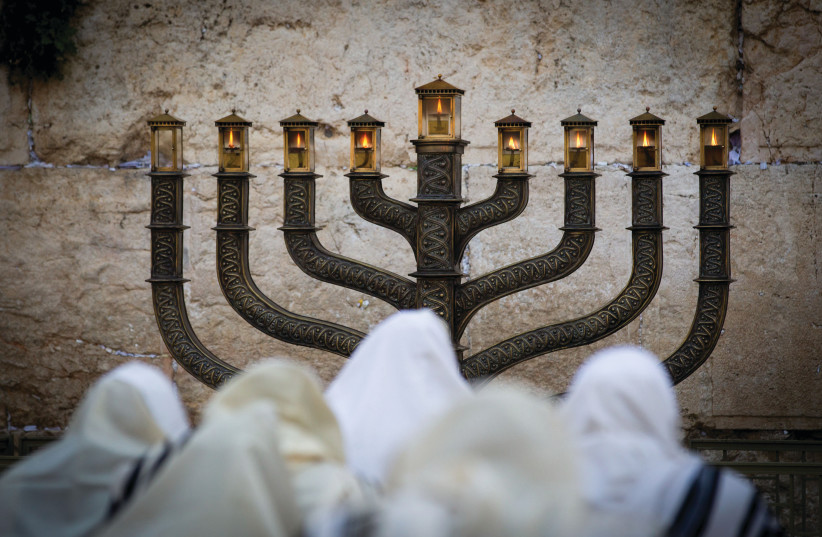What was the Hanukkah miracle?

In the Hampstead Synagogue, our grand hanukkiah was pressed into service one winter when we had an electricity blackout and the shul had no lights.
The eight days of Hanukkah are colorful, exciting and immensely popular, ranking with Purim in carnival spirit. Every type of talent is recruited toward the festival: art, music, drama, cookery. The games are absorbing. The songs center on “Maoz Tzur,” with the annual debate as to whether the Hasof Zeroa Kodshekha stanza is genuine, and attempts to bring the song up to date with a final verse about the Holocaust and the emergence of Israel.
The lights are lit, with the proponents of oil lights pitted against those who prefer candles. The donuts have a range of recipes (never mind how little they signify in the usages of the occasion). The hanukkiot also come in a plethora of shapes. Some hanukkiot are elegant and magnificent; in the Bayswater Synagogue in London years ago we organized a dazzling display ranging from a hanukkiah carved out of a potato, another made of bullet shells, a third built out of toy chairs.
In the Hampstead Synagogue, our grand hanukkiah was pressed into service one winter when we had an electricity blackout and the shul had no lights. All this was Hanukkah in the northern hemisphere winter. In summary, Australia, where I spent many years, Rabbi Mendel Kastel organized a Hanukkah fair in Hyde Park opposite the Great Synagogue, with a public lighting of the hanukkiah.
It wouldn’t do for a holiday to be without its heroes and its villains. It wouldn’t do for there to be any miracles; but which miracles? The Talmud asks in Tractate Shabbat, “What is Hanukkah [what is the main essence of the festival]?” There is one approach in Tractate Yoma, and a different one in Tractate Shabbat. Yoma gives a nationalistic answer, saying the festival marks the conclusion of a brilliant military campaign led by Judah the Maccabee against the Syrian Greeks. Tractate Shabbat gives a spiritual, not a nationalistic explanation: “When the Hasmoneans became strong and overcame the enemy, they searched and could only find one bottle of oil with the seal of the high priest. It only contained enough oil for one day. A miracle occurred, and they lit the menorah with it for eight days.”
The menorah problem was only one issue. The traditionalists “took counsel about the altar of burnt offering, which had been defiled.”
Maimonides’ Laws of Hanukkah say, “When Israel prevailed over their enemies and destroyed them, it was the 25th of Kislev. They entered the sanctuary but did not find any pure oil except for one jar in which there was only enough for one day. With it, they lit the lights of the menorah, which continued to burn for eight days until they could crush olives to produce pure oil.”
If the miracle was spiritual, why did the oil need to keep burning for eight days? The following are some of the theories:
- To get a fresh supply of pure oil took four days of journeying from Jerusalem, and four days to return.
- The experts able to produce fresh oil had become ritually impure and had to wait for the defilement to pass. They could then prepare the fresh oil on the eighth day.
- Seven days were needed to rebuild the altar and the sacred vessels of the sanctuary. Only then could the seventh day be devoted to preparing fresh oil.
- There were actually two miracles. One is the discovery of the one-day supply of oil, the second the continuation of the day’s supply for a further week.
In a Hanukkah shiur, Rav J.B. Soloveitchik does not deny either miracle, the nationalistic or the spiritual. But he holds that the festival serves another purpose, the rededication of the altar. If the main thing is the miracle of the oil, it is hard to understand why the Torah readings on Hanukkah recall the dedication of the altar by the princes of the tribes. If the main thing is the oil for the menorah, we would read Torah passages about the construction and use of the menorah.
The passages about the dedication of the altar imply that the miracle of the oil was not an end in itself but a stage in the overall rededication, which was where the Maccabean effort was leading. “Hanukkah” means “dedication,” and the festival derives its name not from the oil but from the restoration of the altar.
The Soloveitchik approach, like the story of the jar of oil, exemplifies the rabbinic insistence that Hanukkah was a battle for the soul of the Jew. When challenges need to be addressed, what should a Jew think and feel; how does a Jew express Jewish identity? The Jewish spiritual and cultural tradition must be preserved. If Jews focus on battles and not blessings, on fighting and not faith, a crucial dimension is missing.
The writer is emeritus rabbi of the Great Synagogue, Sydney.
Jerusalem Post Store
`; document.getElementById("linkPremium").innerHTML = cont; var divWithLink = document.getElementById("premium-link"); if (divWithLink !== null && divWithLink !== 'undefined') { divWithLink.style.border = "solid 1px #cb0f3e"; divWithLink.style.textAlign = "center"; divWithLink.style.marginBottom = "15px"; divWithLink.style.marginTop = "15px"; divWithLink.style.width = "100%"; divWithLink.style.backgroundColor = "#122952"; divWithLink.style.color = "#ffffff"; divWithLink.style.lineHeight = "1.5"; } } (function (v, i) { });

